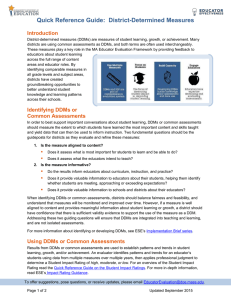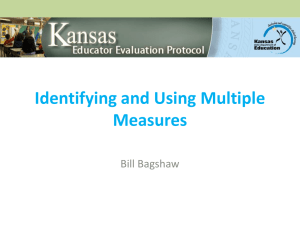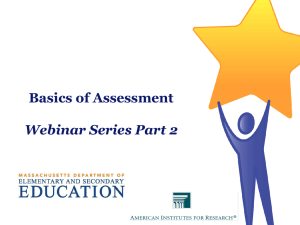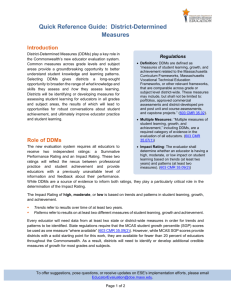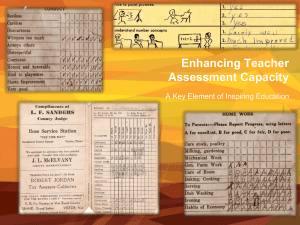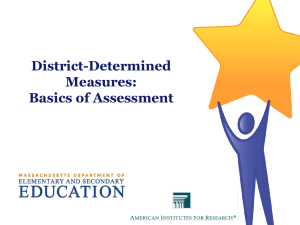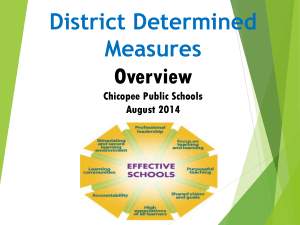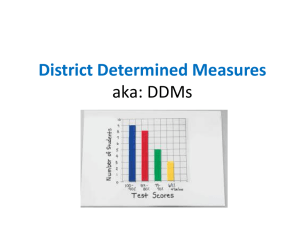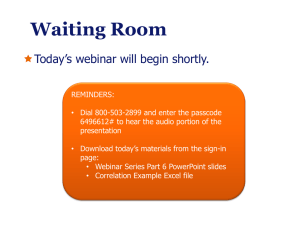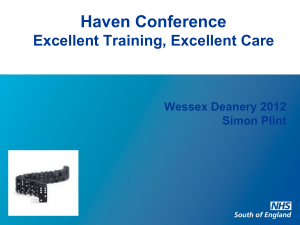DDM Webinar Part 3 - Massachusetts Department of Education
advertisement
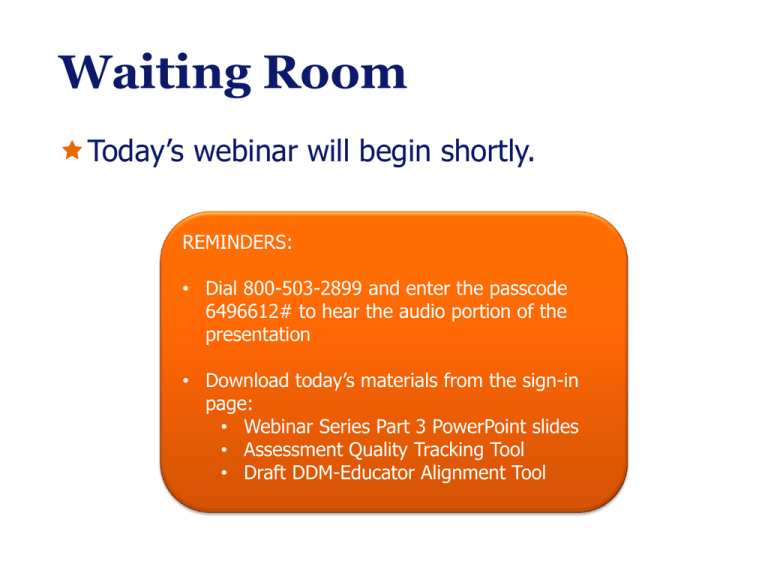
Waiting Room Today’s webinar will begin shortly. REMINDERS: • Dial 800-503-2899 and enter the passcode 6496612# to hear the audio portion of the presentation • Download today’s materials from the sign-in page: • Webinar Series Part 3 PowerPoint slides • Assessment Quality Tracking Tool • Draft DDM-Educator Alignment Tool Assessment Options Webinar Series Part 3 Logistics Q&A Type your questions into the chat box in the lower right corner of the screen Recording Recordings will be archived on our webpage: http://www.doe.mass.edu/edeval/ddm/webinar.html Supplemental materials All materials needed to participate in each session will be posted on the sign-in page and archived on our webpage. 2 Webinar Series Title Date Length Time 1 Introduction: District-Determined Measures and Assessment Literacy 3/14 60 minutes 4-5pm ET 2 Basics of Assessment 4/4 90 minutes 4-5:30pm ET 3 Assessment Options 4/25 60 minutes 4-5pm ET TA and Networking Session I TBD 7/18 60 minutes 4-5pm ET 8/15 60 minutes 4-5pm ET 8/29 60 minutes 4-5pm ET 4 5 6 Determining the Best Approach to DistrictDetermined Measures Integrating Assessments into Educator Evaluation: Reporting Student Growth Integrating Assessments into Educator Evaluation: Developing Business Rules and Engaging Staff TA and Networking Session II 9/19 7 Communicating results 10/24 60 minutes 4-5pm ET 8 Sustainability 12/5 60 minutes 4-5pm ET TA and Networking Session III 12/12 Audience & Purpose Target audience District teams that will be engaged in the work of identifying and selecting District-Determined Measures Purpose Participants will: Understand the details of the revised DDM implementation timeline and the implications for the work of their district teams Learn how to apply the concepts introduced in Part 2 of the series to conduct an inventory of the district’s assessments Understand how to begin to match potential DDMs with educators and conduct an analysis of where assessment gaps exist 4 Agenda Student Impact Rating Regulations Revised Implementation Timeline Opportunity for Educators Assessment Quality Tracking Tool DDM-Educator Alignment Tool Matching Assessments to Educator Roles Q&A and Next Steps 5 Student Impact Rating Regulations For each educator there must be at least two measures. Options – 603 CMR 35.07(1)(a)(3-5) Statewide growth measure(s)* District-determined Measure(s) of student learning comparable across grade or subject district-wide. For educators whose primary role is not as a classroom teacher, the appropriate measures of the educator's contribution to student learning, growth, and achievement set by the district. * Must be used where available (603 CMR 35.09(2)(a)(1)) 6 Student Impact Rating Regulations Evaluators must assign a rating based on trends (at least 2 years) and patterns (at least 2 measures) Options – 603 CMR 35.09(3)(a-c) high indicates significantly higher than one year's growth relative to academic peers in the grade or subject. moderate indicates one year's growth relative to academic peers in the grade or subject. low indicates significantly lower than one year's student learning growth relative to academic peers in the grade or subject. 7 Student Impact Rating Regulations Why focus on growth? Level playing field Fairness Achievement measures may be acceptable when the district judges them to be the most appropriate/feasible measure for certain educators 8 Agenda Student Impact Rating Regulations Revised Implementation Timeline Opportunity for Educators Assessment Quality Tracking Tool DDM-Educator Alignment Tool Matching Assessments to Educator Roles Q&A and Next Steps 9 Revised Implementation Timeline Commissioner’s Memo - 4/12/13 2013-2014 – districts pilot and identify DDMs 2014-2015 – districts implement DDMs and collect the first year of trend data 2015-2016 – districts collect the second year of trend data and issue Student Impact Ratings for all educators Districts positioned to accelerate the timeline should proceed as planned. 10 Revised Implementation Timeline Minimum Piloting Requirements Early grade (K-3) literacy Early (K-3) grade math Middle grade (5-8) math High school writing to text Traditionally non-tested grades and subjects (e.g., fine arts, music, physical education) If a district is unable to identify a DDM in the grades and subjects listed above, the district must pilot one of ESE’s exemplar DDMs to be released in summer 2013. 11 Revised Implementation Timeline Reporting Requirements September 2013: The identified potential DDMs the district will pilot during the 2013-2014 school year and the grades and subjects to which they are aligned (must address minimum requirements) The grades and subjects for which the district has not identified potential DDMs and will research and/or develop measures to pilot in the spring 2014. February 2014: The final plan for determining Impact Ratings based on the DDMs for all educators by the end of the 2015-2016 school year. 12 Agenda Student Impact Rating Regulations Revised Implementation Timeline Opportunity for Educators Assessment Quality Tracking Tool DDM-Educator Alignment Tool Matching Assessments to Educator Roles Q&A and Next Steps 13 Opportunity for Educators Good assessments benefit both students and teachers DDMs Higher Quality Student Data Better Teaching Improved Student Outcomes Closely tied to one of the key goals of the new educator evaluation framework: To promote student learning, growth, and achievement by providing educators with feedback for improvement. 14 Agenda Student Impact Rating Regulations Revised Implementation Timeline Opportunity for Educators Assessment Quality Tracking Tool DDM-Educator Alignment Tool Matching Assessments to Educator Roles Q&A and Next Steps 15 Assessment Quality Tracking Tool Purpose Help district teams in thinking about assessments that may be used as DDMs and how to apply the concepts introduced in Part 2 to evaluate them Provide district teams with a space to record information about potential DDMs in a systematic, organized way Send feedback to Ron Noble – rnoble@doe.mass.edu 16 Information Prompts 1. 2. 3. 4. 5. 6. 7. 8. 9. Grade/Subject or Course Name Source Type Type of Items Assessment Components Alignment and Rigor Validity, Reliability, and Non-Bias Feasibility 17 Tracking Tool Walkthrough 18 Agenda Student Impact Rating Regulations Revised Implementation Timeline Opportunity for Educators Assessment Quality Tracking Tool DDM-Educator Alignment Tool Matching Assessments to Educator Roles Q&A and Next Steps 19 DDM-Educator Alignment Tool Purpose To provide district teams with a draft tool to use when beginning to match potential DDMs to educators. Supports a “Gap Analysis” to identify where there are gaps in the alignment of potential assessments to educators and courses within the district “Working” Document Send feedback to Ron Noble – rnoble@doe.mass.edu 20 DDM-Educator Alignment Tool Structure Cover Page ReadMe Instructions Educators & Courses DDM Summary DDM Descriptions Course Lookup 21 Alignment Tool Walkthrough 22 Agenda Student Impact Rating Regulations Revised Implementation Timeline Opportunity for Educators Assessment Quality Tracking Tool DDM-Educator Alignment Tool Matching Assessments to Educator Roles Q&A and Next Steps 23 National Perspective – Beyond Reading and Math Measures Schoolwide growth or value-added scores Developing additional assessments to measure student growth Student learning objectives (SLOs) Massachusetts already includes a separate student learning goal component in teacher summative ratings 24 Schoolwide Growth What do we mean by schoolwide growth measures? Often, this means taking existing value-added or growth measures in reading and mathematics and applying them to individual teachers in other subjects or administrators (teachers or administrators may select measures). Need not focus only on existing measures on reading or mathematics, however—e.g., team-based SLOs or subjects in which a small number of teachers represent the work of the school. Could be extended to nonacademic areas as well. Examples: TN; TAP; Washington, DC (http://www.tapsystem.org/; http://www.dc.gov/DCPS/impact) 25 Developing New Assessments Creating lists of “approved” assessments for use in the state NY, OH (http://usny.nysed.gov/rttt/teachersleaders/assessments/) Developing new statewide assessments using internal teams and/or vendors NC, DE, FL (http://www.dpi.state.nc.us/effectiveness-model/) Providing guidance for local assessment development MA, CO 26 Agenda Student Impact Rating Regulations Revised Implementation Timeline Opportunity for Educators Assessment Quality Tracking Tool DDM-Educator Alignment Tool Matching Assessments to Educator Roles Q&A and Next Steps 27 Register for Webinar Series Part 4 Determining the Best Approach to DistrictDetermined Measures In Part 4, participants will learn about various approaches to identifying district-determined measures and will determine whether that means building, buying, or borrowing assessments. Districts will need to have completed Parts 2 and 3 and their activities prior to beginning Part 4. Date: July 18, 2013 Time: 4-5pm EST (60 minutes) Register: https://air-event500.webex.com/airevent500/onstage/g.php?d=595709119&t=a 28 Questions Contact Ron Noble at rnoble@doe.mass.edu Feedback Tell us how we did: http://www.surveygizmo.com/s3/1228510/Dist rict-Determined-Measures-amp-AssessmentLiteracy-Webinar-3-Feedback 29
